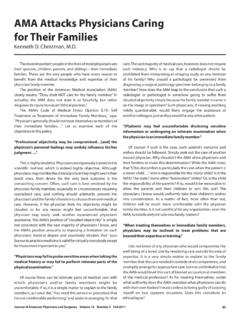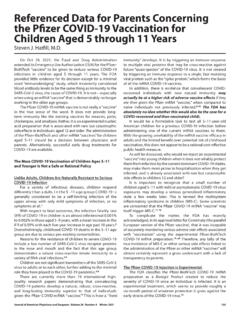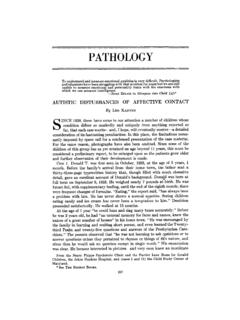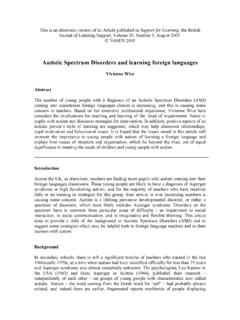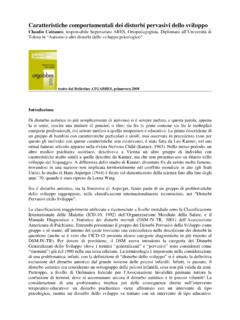Transcription of Autism in the United States: a Perspective
1 F. Edward Yazbak, , BackgroundABSTRACTOnce rare, Autism has reached epidemic proportions in theUnited States. The increase cannot be attributed to changes indiagnostic criteria, which have actually become more a heavy burden on educational facilities, the increasingnumber of patients afflicted with this serious disability will have anenormous effect on the economy as the affected children reachadulthood. Studies of all possible causes of the epidemic areurgently needed. To date, studies of a potential relationship tochildhood vaccines have been limited and important historical observation about Autism is that it wasunknown in ancient cultures, or even in medieval times, and that itjust appeared some 60 years Kanner, while at Johns Hopkins, was first to describeautism in 1943.
2 His articledescribed 11 children who had an apparently raresyndrome of extreme autistic aloneness. Because thesechildren s symptoms started early, Kanner s Syndrome was alsoknown as infantile Autism . In 1944, Hans Asperger also describeda group of children with similar symptoms who were highlyrecognizable. In the same year, Bruno Bettelheim theorized thatchildren developed Autism because their refrigerator mothers raised them in a non-stimulating environment, with resultingdamage to their social, language and general s credentials were questionable, and his theory hasbeen Rimland, , founder of the Autism Society ofAmerica and founding president of the Autism Research Institute(ARI), has thoroughly analyzed the ARI database of more than30,000 entries and reported two clear trends:First, the incidence of Autism has increased remarkably,becoming an explosion in recent years and second, a distinctshift in the time of onset of autistic symptoms has become evident.
3 Late onset Autism (starting in the second year) was almost unheardof in the 1950s, 60s, and 70s; today such cases outnumber earlyonset cases five to one. Parents in increasing numbers are reporting similar stories. Achild, most often a boy who is developmentally, socially, andverbally on par for his age, suddenly stops acquiring new wordsAutistic Disturbances of AffectiveContact12345and skills in the second year of life and then regresses, losingspeech, cognitive abilities, and social dexterity. Children in thisgroup are said to have regressive Autism . Further, overwhelmedparents may drift apart, and siblings stress may be manifested asbehavior that a sudden and exponential increase in autisticdisorders is not real, and results only from better diagnosis,amounts to denial. Similarly, though some affected children haveFragile-X Syndrome or a family history of Autism , it does not seemreasonable to insist that the present Autism outbreak is solely causedby hereditary factors.
4 Genetic disorders have never presented asepidemics, and investing the scant available resources solely ingenetic research diverts them from the scientific exploration ofmore plausible environmental etiological Individuals with Disabilities Education Act (IDEA) of1975 was intended to ensure equal educational opportunities forchildren with disabilities. State and local education districts mustprovide a free appropriate public education based upon an individualized education program geared to each student sneeds. The Department of Education is mandated to reportyearly to Congress in accordance with in the program, cases of Autism in schools were they steadily increased, a decision was made to list Autism as aseparate entity starting in 1991. As shown in Figure 1, the numberof children aged 6 to 21 with Autism in schools rose steadilyfrom 5,415 in 1991-1992 to 118,602 in the latest publishedDepartment of Education report for the 2001-2002 school StatisticsAutism in the United States: a with a Diagnosis of Autism Attending SchoolsSource: Department of Education Annual Reports to Congress (IDEA)Students with Autism x1000 Age 6-211991-921992-931993-941994-952002-031 995-961996-971997-981998-991999-002000-0 12001-02103 Journal of American Physicians and Surgeons Volume 8 Number 4 Winter 2003 Every state in the has recorded an increase in the numberof students with the diagnosis of Autism .
5 Nine states and theDistrict of Columbia, which recorded the highest increases, areshown in Table is likely that the number of children with Autism will continueto increase as more affected children enter first grade (see Figure 2).According to the New Jersey Department of Education, there were14 students of age 21 with Autism in the state in the last reportedschool year, 2001-2002, compared to 514 students who were age states are reporting the same trend: an increase in the numberof younger children needing services, more programs beingorganized to handle the influx, and an ever increasing number ofspecially trained therapists the last 10 years, the number of children with Autism between6 and 21 years of age attending school in the rose at a muchfaster rate than the number of children with disabilities in general(see Table 2).
6 When IDEA passed in 1975, Congress promised to provide 40percent of the costs associated with the legislation. However, it hasnever actually funded more than 15 percent. State governmentshave also provided a decreasing proportion of the school budgets asstate funds become scarce nationwide. Federal and statecontributions vary greatly from state to state (see Table 3).In addition, state contributions are not evenly distributed, andcities usually receive proportionately more state dollars thansuburban communities, though the latter may have a higher8concentration of affected children. Local taxpayers usually end upbearing the spiraling cost of educating the increasing number ofaffected services are often provided through most of thesummer, and each child with Autism can cost the school system$30,000 a year or more.
7 If an acceptable program is not locallyavailable, the affected child has to be transported to a collaborativeor regional center, where the yearly tuition may be higher. In ruralareas, the cost of providing therapy and educating a single childwith Autism may be , as Autism is diagnosed earlier, services must be madeavailable starting at age 3, and affected children must be enrolledin early intervention programs, which are also expensive to startand a child to receive services in any program, a firm diagnosisof Autism must first be made by a physician. Each case is thenthoroughly reviewed by the special education department in theschool district, which may request more information or turn downthe recommendation. Autism is not a diagnosis that parents acceptreadily, physicians make lightly, or that school authorities approveeasily.
8 In fact, it is probable that Autism in schools is actuallyunderdiagnosed and that many less severe cases are labeledbehavior and communication disorders, in order to avoid the stigmaand/or the added spite of all of the above, some experts still claim that thespectacular increases in Autism reported lately are simply the resultof more liberal or less stringent diagnostic technical recognition of Autism increased along with thenumber of cases, accurate comparisons in prevalence and incidencerates became difficult, if not Kanner s conception, children with Autism were affectedearly and had poor or absent speech; an obsessive desire forpreservation of sameness; lack of affective contact; difficultywith interpersonal communication; and a fascination withspecific Criteria for Autism in the : Department of Education Annual Reports to Congress (IDEA)1992-1993528045022371802002-20035, 0802,9625374816844914,0173, HampshireOhioOregonWisconsinDC1430635873 8112414516520825736043946550551401002003 004005006006789 10 11 12 13 14 15 16 17 18 19 20 21 AgeStudents with AutismFigure with Autism by Age in New Jersey Schools 2001-2002 Source: New Jersey Department of EducationSource: Department of Education Annual Reports to Congress (IDEA)1991-19922001-2002% IncreaseAutism5,31597,8471,700 All Disabilities4,499,9245,853,83030 Source.
9 National Association of State Boards of Education (NASBE)FederalStateLocalNationalAverage$ 18,581,511,000 $127,719,673, $119,538,243,000 $3,443,221,000 $23,736,295,000 $12,379,999,000 $73,870, $548,776, $679,478, of American Physicians and Surgeons Volume 8 Number 4 Winter 2003 Table with the Largest Increases in the Number of Students withAutism, Ages 6 to 21 [1992-93 to 2002-03]Table in Autism and All Disabilities in Schools 1991-92 to2001-02 Table , State and Local Contributions to Education ( , Calif., ) in 2000In 1956, Kanner and Eisenberg proposed that justessentialfeatures were required to make a diagnosis of Autism : profound lackof affective contact and repetitive, ritualistic, elaborate 1978, Rutter proposed that a definition of Autism in childrenrequiredcriteria: (1) Impaired social development out ofkeeping with the child s intellectual level; (2) impaired language1213twofourdevelopment out of keeping with the child s intellectual level; (3)stereotyped play patterns, abnormal preoccupations, and resistanceto change; and (4) onset before the age of 30 1980, DSM III (, Third Edition),was introduced, and its classificationof infantile Autism requiredcriteria: (1) Lack of responsivenessto others; (2) language absence or abnormalities; (3) resistance tochange or attachment to objects.
10 (4) absence of schizophrenicfeatures; and (4) onset before 30 1987, the diagnostic criteria for Autism were revised (DSMIII-R), and a definition of pervasive developmental disorders wasintroduced. Other countries had their own sets of 1994, the required criteria for Autistic Disorder been those established in the DSM IV, shown in Table , detailed and strict criteria were outlined for Asperger sSyndrome (AS) and Pervasive Developmental Disorder, NotOtherwise Specified (PDD-NOS) and Statistical Manual of MentalDisordersfive11,141115(I) A total of six or more items from (A), (B), and (C), with at least two from (A), andone each from (B) and (C):(A) Qualitative impairment in social interaction, as manifested by at least twoof the following:1. Marked impairments in the use of multiple nonverbal behaviors suchas eye-to-eye gaze, facial expression, body posture, and gestures toregulate social interaction2.


